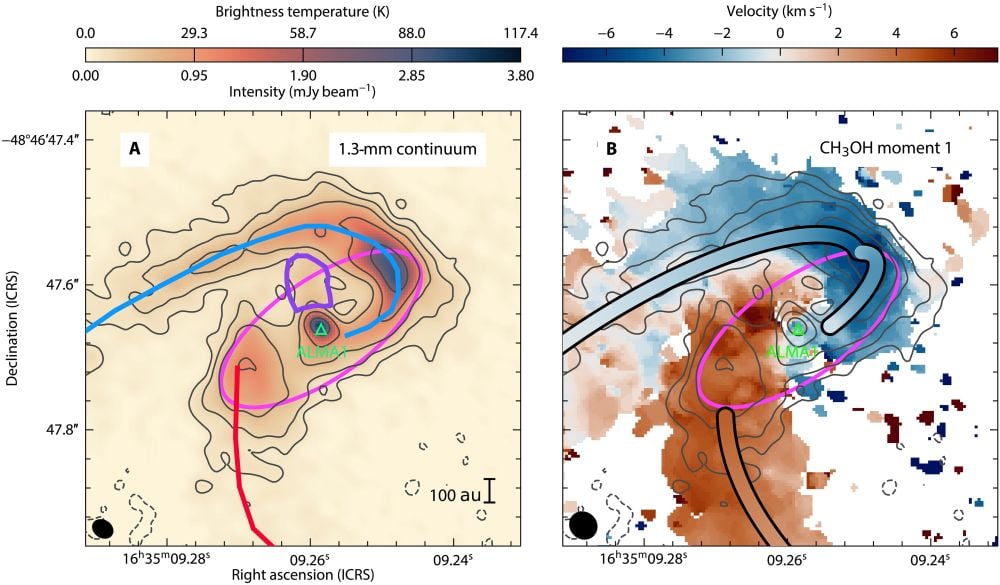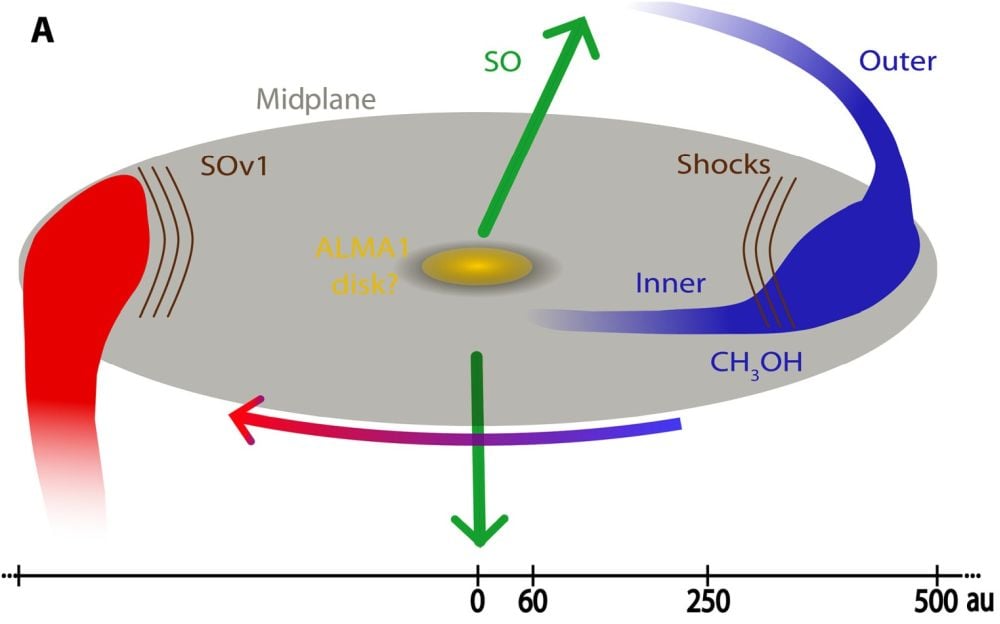High-mass stars with eight or more solar masses are mysterious. Despite the fact that they're more easily observed than their lower-mass counterparts, astrophysicists have struggled to explain how they become so massive. The problem is that while they accrete material and become more massive, they're also shedding mass.
Stars form in clouds of predominantly hydrogen called giant molecular clouds. Thousands or even millions of stars can form in a single massive cloud. As a protostar forms, it gathers material from the cloud into a swirling accretion disk around itself. The young star accretes matter directly from this disk.
But at the same time that it's accreting matter and growing, the young star is also getting rid of some of its mass through stellar winds and bipolar outflows called protostellar jets.
 This artist's illustration shows a young protostar inside a cloud of gas. A swirling accretion disk surrounds the star, and protostellar jets are emitted from each pole. Image Credit: NASA/JPL-Caltech/R. Hurt (SSC)
This artist's illustration shows a young protostar inside a cloud of gas. A swirling accretion disk surrounds the star, and protostellar jets are emitted from each pole. Image Credit: NASA/JPL-Caltech/R. Hurt (SSC)
The powerful jets coming from young stars carry mass away from the stars and can also create cavities in the surrounding material. Both of these phenomenon can limit a star's growth. Some theory shows that this should limit the mass of stars to between 20 to 40 solar masses, yet astronomers routinely observe stars much more massive than this. The list of the most massive stars contain many stars between 100 and 200 solar masses, and the single most massive star known, R136a1, is almost 300 solar masses.
This issue is one of the most active issues in astrophysics. How do massive stars become so massive? The question is made more challenging because observing high-mass stars while they're forming is difficult. The process is hidden inside opaque clouds of gas and occurs very rapidly. Much of what astrophysicists know about high-mass stars comes from simulations and indirect evidence.
New research in Science Advances may have the answer. It's titled "Massive extended streamers feed high-mass young stars," and the lead author is Fernando Olguin. Olguin is from the Center for Gravitational Physics at Kyoto University.
Olguin and his colleagues used the Atacama Large Millimeter/submillimeter Array (ALMA) to observe a high-mass star formation region named G336 ALMA1 about 10,100 light-years away. They found streamers feeding gas from the surrounding clouds directly onto a protostar without an accretion disk.
"Our work seems to show that these structures are being fed by streamers, which are flows of gas that bring matter from scales larger than a thousand astronomical units, essentially acting as massive gas highways," said lead author Olguin.
The young star is being fed by one streamer, possibly by two. They're like spiral arms that feed gas from the surrounding region into the region where the star is forming. One of the streamers is more directly connected to the central region where the star is forming. Measurements of the streamer suggest that it delivers so much gas to the still-growing star that it quenches the feedback effects that can otherwise limit the star's mass accretion.
 These figures show some of the ALMA observations of G336 ALMA1. The left panel shows the 1.3 mm continuum that reveals the movement of cold gas and dust. The blue and red lines represent the blue-shifted and red-shifted streamers respectively. The right panel shows the emission from hot methanol. It shows a clear connection between the blue-shifted streamer and the young star ALMA1. Image Credit: Olguin et al. 2025. SciAdv
These figures show some of the ALMA observations of G336 ALMA1. The left panel shows the 1.3 mm continuum that reveals the movement of cold gas and dust. The blue and red lines represent the blue-shifted and red-shifted streamers respectively. The right panel shows the emission from hot methanol. It shows a clear connection between the blue-shifted streamer and the young star ALMA1. Image Credit: Olguin et al. 2025. SciAdv
Previous observations showed these streamers, but they weren't high enough resolution to observe the central region clearly. Those observations suggested that the streamers were feeding a disk. But these newer ALMA observations show there's no disk, or perhaps only an extremely limited one.
"We found streamers feeding what at that time was thought to be a disk, but to our surprise, there is either no disk or it is extremely small," says Olguin.
 This schematic from the research shows the different kinematic components and flow scenarios for the protostar ALMA1. Green arrows represent outflows, the blue and red represent the streamers of gas, and the red to blue arrow shows rotation. Image Credit: Olguin et al. 2025. SciAdv
This schematic from the research shows the different kinematic components and flow scenarios for the protostar ALMA1. Green arrows represent outflows, the blue and red represent the streamers of gas, and the red to blue arrow shows rotation. Image Credit: Olguin et al. 2025. SciAdv
If young stars can gather mass from streamers without the need for an intermediating disk, then that can explain how stars become so massive. They essentially bypass limitation to their growth.
"The case of G336 ALMA1 shows that streamers can play an important role in feeding high-mass protostars," the researchers explain in their paper. "To continue accreting gas, the density around the source has to be high enough to quench the feedback from the young star or the momentum carried by the streamers has to be high enough to overcome the feedback in the absence of a disk."
Researchers have detected streamers feeding stars before, but only low-mass stars. A 2022 paper found a streamer feeding into the disk surrounding a young star. "The streamer is delivering more than enough mass to sustain its protostellar accretion rate," those researchers wrote.
But these streamers are much more massive, as is the star ALMA1.
"We estimate masses between 0.3 and 0.6 solar masses for each inner streamer," the authors write. "These masses and the resulting infall rates are an order of magnitude or higher than those found in streamers feeding low-mass stars."
There could still be a small accretion disk around the star, and it could be the last link in the chain of matter that feeds the star. But the disk's mass, if it's there, is comparable or lower than the mass of the streamers.
"It is thus the large mass of the reservoir, at large scales, and the streamers, at small scales, that have allowed the formation and continuous feeding of the young high-mass star at the center of ALMA1," the researchers conclude.

